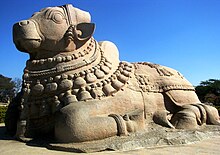
Back অন্ধ্রপ্রদেশের ইতিহাস Bengali/Bangla आन्ध्र प्रदेश का इतिहास Hindi Andhros istorija Lithuanian آندھرا پردیش دی تریخ PNB ஆந்திரப் பிரதேச வரலாறு Tamil ఆంధ్రప్రదేశ్ చరిత్ర Tegulu ประวัติศาสตร์รัฐอานธรประเทศ Thai آندھرا پردیش کی تاریخ Urdu
This article may require cleanup to meet Wikipedia's quality standards. The specific problem is: organization and unclear timeline. (November 2021) |
| Part of a series on the |
| Culture of Andhra Pradesh |
|---|
 |
| History |
| People and culture |
| Part of a series on |
| Andhra Pradesh and Telangana |
|---|
 |
| History and Kingdoms |
The recorded history of Andhra Pradesh, one of the 28 states of 21st-century India, begins in the Vedic period. It is mentioned in Sanskrit epics such as the Aitareya Brahmana (800 BCE).[1][2][3] Its sixth-century BCE incarnation Assaka lay between the Godavari and Krishna Rivers,[4] one of sixteen mahajanapadas (700–300 BCE). The Satavahanas succeeded them (230 BCE–220 CE), built Amaravati, and reached a zenith under Gautamiputra Satakarni.
After the Satavahanas, the region fragmented into fiefdoms. By the late second century CE, Andhra Ikshvakus ruled along the Krishna River. In the fourth century CE, the Pallava dynasty ruled southern Andhra Pradesh and Tamilakam, and had a capital at Kanchipuram. Their power increased in the reigns of Mahendravarman I (571–630) and Narasimhavarman I (630–668), and dominated northern Tamilakam and the southern Telugu-speaking region until the end of the ninth century.[clarification needed]Northern Andhra Pradesh was under Vengi Chalukyas starting from 624 CE. Later during 1002 CE Vengi Chalukyas became subordinate of Imperial Cholas when Rajaraja Chola I helped Vengi Chalukyas to secure the Vengi throne from Telugu Chola king Jata Choda Bhima. From 1002 CE till 1206 CE Andhra Pradesh was under Imperial Cholas.
From 1206 CE to 1323 CE the Kakatiya dynasty unified the land and in that golden age Tikkana’s translation of the Mahabharata founded Telugu literature. In 1258 CE, Pandyan emperor Jatavarman Sundara Pandyan I defeated Nellore Cholas and Kakatiyas, extending Pandyan empire till Nellore. Kakatiyas unified the Andhra again during internal crisis in Pandyan empire. In 1323 CE, Ghiyath al-Din Tughluq, sultan of Delhi, sent a large army under Ulugh Khan[5] to lay siege to Warangal. After the Kakatiya dynasty fell, the Delhi Sultanate, and the Persio-Tajik sultanate of central India competed for the region. In the end the Musunuri Nayaks won over Delhi.
Under Krishnadevaraya of the Vijayanagara Empire (1336 CE–1646 CE) the Telugus became independent, then the Qutb Shahi dynasty ruled the Bahmani Sultanate there from the early 16th to the end of the 17th centuries, and was tolerant of Telugu culture.
The French, under the Marquis de Bussy-Castelnau, and the English, under Robert Clive, altered the regional polity. In 1765 CE, Clive and the chief and council at Visakhapatnam obtained the Northern Circars from Mughal emperor Shah Alam. The British later defeated Maharaja Vijaya Rama Gajapati Raju of Vizianagaram, in 1792 CE.
Andhra State was created in the year 1953 CE. Potti Sriramulu had campaigned for a state independent of the Madras Presidency, and Tanguturi Prakasam Pantulu social-reform movements led to the founding of Andhra State, with a capital at Kurnool and freedom-fighter Pantulu as its first chief minister. A democracy with two stable political parties and a modern economy emerged under the N. T. Rama Rao.
India became independent in 1947. The Nizam of Hyderabad, Mir Osman Ali Khanto, wanted to remain independent, but in 1948 the Indian Army annexed Hyderabad to the Dominion of India, where it became Hyderabad State. Andhra Pradesh, the first Indian state formed primarily on the basis of language post independence, split off from the Madras Presidency in 1953. Andhra State merged with the Telugu-speaking portion of Hyderabad State in 1956 to create the state of Andhra Pradesh.
The Lok Sabha formed Telangana from ten districts of Andhra Pradesh on 18 February 2014.[6]
- ^ Ragini Devi (1990). Dance Dialects of India. Motilal Bansarsi Dass. ISBN 81-208-0674-3. Retrieved 9 June 2014.
- ^ "History of Andhra Pradesh". AP Online. Government of Andhra Pradesh. Archived from the original on 16 July 2012. Retrieved 22 July 2012.
- ^ P. Raghunadha Rao (1993). Ancient and medieval history of Andhra Pradesh. Sterling Publishers, 1993. p. iv. Retrieved 9 June 2014.
- ^ Bimala Churn Law. (7 May 2024). Ancient Indian Tribes. Osmania University, Digital Library Of India. Motilal Banarsidas.
- ^ later Muhammad bin Tughluq, the Delhi sultan
- ^ Menon, Amamath K. (1 June 2014). "Telangana is born, KCR to take oath as its first CM". India Today. Archived from the original on 11 November 2014. Retrieved 15 September 2016.